跨文化交际期末考试题
- 格式:doc
- 大小:17.50 KB
- 文档页数:4
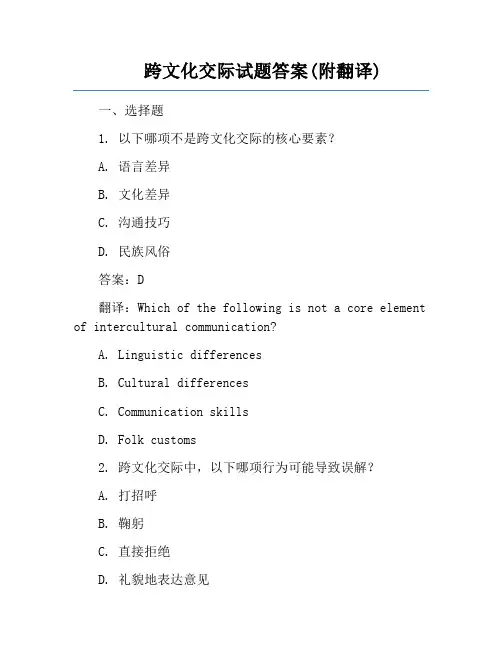
跨文化交际试题答案(附翻译)一、选择题1. 以下哪项不是跨文化交际的核心要素?A. 语言差异B. 文化差异C. 沟通技巧D. 民族风俗答案:D翻译:Which of the following is not a core element of intercultural communication?A. Linguistic differencesB. Cultural differencesC. Communication skillsD. Folk customs2. 跨文化交际中,以下哪项行为可能导致误解?A. 打招呼B. 鞠躬C. 直接拒绝D. 礼貌地表达意见翻译:In intercultural communication, which behavior may lead to misunderstandings?A. GreetingB. BowingC. Direct refusalD. Politely expressing opinions二、填空题1. 跨文化交际中的文化差异主要体现在____、____、____等方面。
答案:价值观、行为规范、语言使用翻译:The cultural differences in intercultural communication are mainly reflected in values, behavioral norms, and language use.2. 跨文化交际能力包括____、____、____等方面。
答案:知识、技能、态度翻译:Intercultural communication competence includes knowledge, skills, and attitudes.三、简答题1. 简述跨文化交际的重要性。
跨文化交际在全球化背景下具有重要意义。
以下是跨文化交际的重要性:(1)促进国际交流与合作:跨文化交际有助于不同国家和地区的人们相互了解,增进友谊,促进国际合作。

跨文化交际期末考试复习题Define the following items:1.intercultural communication: is simply defined as interpersonal communication between people from different cultural background.2.interethnic communication: refers to communication between people of the same race but different ethnic backgrounds.3.verbal communication:communication done both orally and in written language.4.nonverbal communication: involves all nonverbal stimuli i n a communication setting that is generated by both the source and his or her use of the environment and that has potential message value for the source or receiver.4. Monochronic time一元时间观念: means paying attention to and doing only one thing at a time.5. Polychronic time多元时间观念: means being involved with many things at once.6. ethnocentrism :the view of things in which one’s own group is the center of everything, and all others are scaled and rated with reference to it.7. stereotypes:refers to negative or positive judgment made about individuals based on any observable or believed groupmembership.针对目标群体成员所特有的正面或方面的判断。
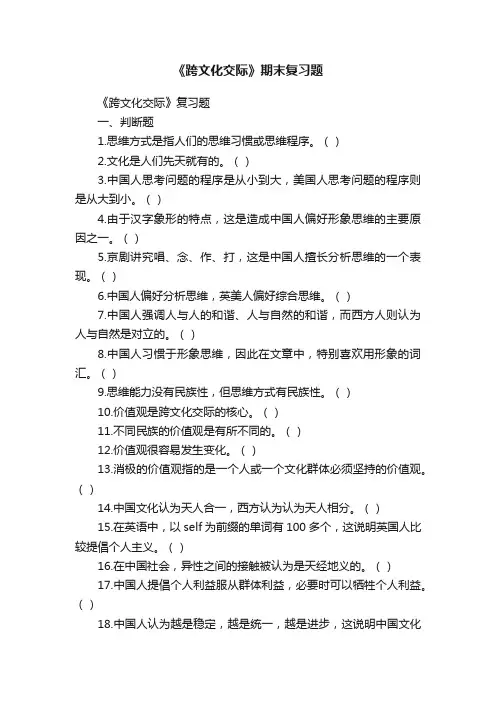
《跨文化交际》期末复习题《跨文化交际》复习题一、判断题1.思维方式是指人们的思维习惯或思维程序。
()2.文化是人们先天就有的。
()3.中国人思考问题的程序是从小到大,美国人思考问题的程序则是从大到小。
()4.由于汉字象形的特点,这是造成中国人偏好形象思维的主要原因之一。
()5.京剧讲究唱、念、作、打,这是中国人擅长分析思维的一个表现。
()6.中国人偏好分析思维,英美人偏好综合思维。
()7.中国人强调人与人的和谐、人与自然的和谐,而西方人则认为人与自然是对立的。
()8.中国人习惯于形象思维,因此在文章中,特别喜欢用形象的词汇。
()9.思维能力没有民族性,但思维方式有民族性。
()10.价值观是跨文化交际的核心。
()11.不同民族的价值观是有所不同的。
()12.价值观很容易发生变化。
()13.消极的价值观指的是一个人或一个文化群体必须坚持的价值观。
()14.中国文化认为天人合一,西方认为认为天人相分。
()15.在英语中,以self为前缀的单词有100多个,这说明英国人比较提倡个人主义。
()16.在中国社会,异性之间的接触被认为是天经地义的。
()17.中国人提倡个人利益服从群体利益,必要时可以牺牲个人利益。
()18.中国人认为越是稳定,越是统一,越是进步,这说明中国文化19.中国的主流文化主张性恶论。
()20.西方文化认为一切行为必须在法律法规的范围内进行,否则就会被绳之以法。
这说明西方文化是性善论。
()21.邻里、老乡属于业缘关系。
()22.同事、同学、战友属于情缘关系。
()23.朋友、恋人之间的关系属于血缘关系。
()24.中国所处的自然地理位置决定了中国的农业文化特征,而西方的海洋环境决定了西方文化的商业性质。
()25.西方崇尚民主政治,具有平等意识。
()26.中国社会的人际关系以工具型为主要取向。
()27.规则和规范是一回事。
()28.在中国,给新婚夫妇送礼品忌讳送钟,因为送“钟”就是“送终”。
()29.在日本,人们比较忌讳数字“13”。
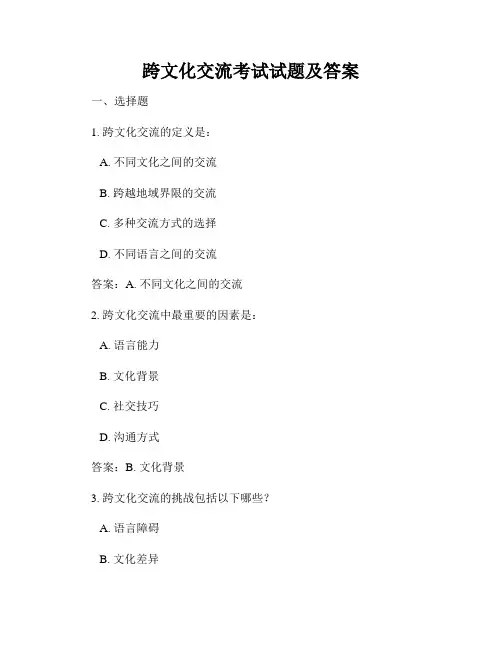
跨文化交流考试试题及答案一、选择题1. 跨文化交流的定义是:A. 不同文化之间的交流B. 跨越地域界限的交流C. 多种交流方式的选择D. 不同语言之间的交流答案:A. 不同文化之间的交流2. 跨文化交流中最重要的因素是:A. 语言能力B. 文化背景C. 社交技巧D. 沟通方式答案:B. 文化背景3. 跨文化交流的挑战包括以下哪些?A. 语言障碍B. 文化差异C. 社交礼仪D. 打破隔阂答案:A. 语言障碍、B. 文化差异4. 在跨文化交流中,以下哪些行为是不恰当的?A. 尊重对方的文化习惯B. 使用简单明了的语言表达C. 批评对方的文化观念D. 遵守当地的社交礼仪答案:C. 批评对方的文化观念5. 跨文化交流的好处包括:A. 增进文化理解B. 缩小文化差异C. 促进国际合作D. 创造更多商机答案:A. 增进文化理解、C. 促进国际合作、D. 创造更多商机二、问答题1. 请简要说明跨文化交流的意义和价值。
跨文化交流具有重要的意义和价值。
首先,它可以增进不同文化之间的理解和尊重,消除误解和偏见,促进友好合作关系的建立。
其次,跨文化交流可以促进文化的多元发展和融合,丰富人们的思想和观念。
此外,跨文化交流有助于拓展商务和经济合作的机会,加强国际间的互利互惠关系。
总之,跨文化交流对于推动全球化进程、促进世界和平与繁荣具有重要的作用。
2. 请列举三种跨文化交流中常见的误解和解决方法。
常见误解:a. 语言障碍:不同语言之间存在的语言障碍常导致误解,解决办法可以是提前学习对方的语言,或者借助翻译工具和专业人士进行沟通。
b. 礼仪差异:不同文化间存在的社交礼仪差异容易导致误解,解决办法是提前了解对方的文化礼仪,尊重对方的习惯,并在交流中保持开放和灵活的态度。
c. 价值观冲突:不同文化之间的价值观存在差异,可能导致观念冲突和摩擦。
解决办法是理解对方的文化背景,尊重差异,以合作和共同利益为出发点,寻求共识和妥善处理分歧。
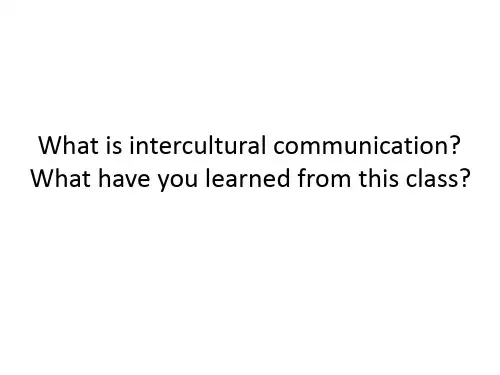
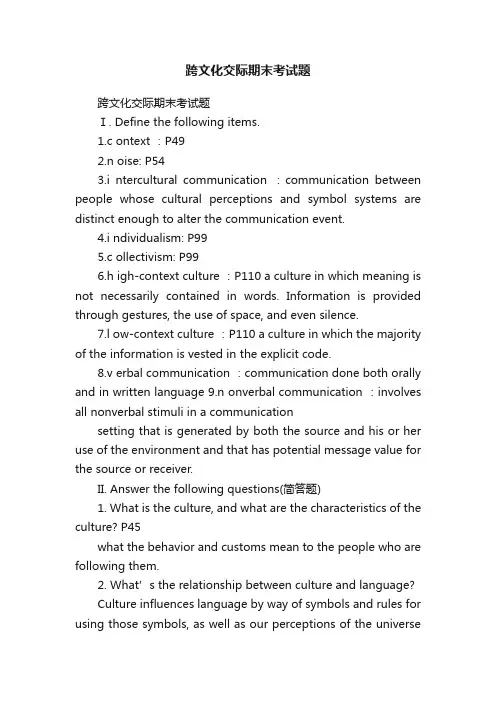
跨文化交际期末考试题跨文化交际期末考试题Ⅰ. Define the following items.1.c ontext :P492.n oise: P543.i ntercultural communication :communication between people whose cultural perceptions and symbol systems are distinct enough to alter the communication event.4.i ndividualism: P995.c ollectivism: P996.h igh-context culture :P110 a culture in which meaning is not necessarily contained in words. Information is provided through gestures, the use of space, and even silence.7.l ow-context culture :P110 a culture in which the majority of the information is vested in the explicit code.8.v erbal communication :communication done both orally and in written language 9.n onverbal communication :involves all nonverbal stimuli in a communicationsetting that is generated by both the source and his or her use of the environment and that has potential message value for the source or receiver.II. Answer the following questions(简答题)1. What is the culture, and what are the characteristics of the culture? P45what the behavior and customs mean to the people who are following them.2. What’s the relationship between culture and language?Culture influences language by way of symbols and rules for using those symbols, as well as our perceptions of the universe(the meaning associated with the symbols).Language, on the other hand, would seem to have a major impact on the way an individual perceives and conceptualizes the world.3. How do Japanese people refuse? P1354. How do Chinese and western people respond to others’ compliment? P1625. What kinds of nonverbal communication are often used in our daily communication? P1916. What are the functions of the nonverbal communication? P2187.What are the differences on receiving gift s between Chinese and westerner?In the West, it is regarded as polite to open gifts as soon as they are given to express appreciation. In China, the situation is quite the reverse. Norma lly we Chinese feel that if you open the gift as soon as it is given, you might embarrass the person wh o gives the gift and you might be thought greedy. Therefore, Chinese people tend to open the gifts af ter the visitors have left.In China, many people send gifts without wrappi ng them, and if they wrap them, they usually tell t he receiver what is inside, and the receiver will tha nk the sender and put the gift aside without unwra pping them since they already know what is insid e. English receivers open the gifts in front of the se nders of the gifts.8.Describe the different ways in showing hospitality between Chinese culture and west ern culture.Chinese guests always refuse offer of drinks or food to demonstrate politeness in seeming not to wish to put their host to any trouble.Sometimes an offer is not a real offer but a polite remark. After we say 'no', we usually wait for the second and third offer. If the host just brings the food or drink an d ignores 'no', we ill accept it. Chinese like to press their guests to drink or eat to show their hospitalit y. While westerners always accept or refuse offer of drinks or food very genuinely.Their refusal is acce pted as genuine.Westerners don’t to press. To pres s people to have food or drink after they have refu sed is frowned upon and can cause embarrassment s.III. Case Analysis (You are required t o state cultural phenomenon in each cas e)Case 1Li Lan had an American friend Susan. They usually had lunch together and Li Lan often asked Susan for advice on problems she face d adjusting to American society. Susan gave Li Lan a lot of advice and helped her to impro ve her English. Once Li Lan needed urgently a big sum of money to pay her tuition fee. Si nce she has no other friends in the States, sh e turned to Susan for help and promised that she would return the money soon.To Li Lan’s great disappointment, this time Susan didn’t seem happy to lend the moneyto her. Though Li Lan returned the money as she promised, they didn’t get along well from then on.Question: Why did Li Lan feel unpleasant?Li Lan asked to borrow money from her A merican friend Susan, which is rarely part of Western friendship. Li Lan and Susan have di fferent expectations of friendship.In the West, people prefer to be independe nt and equal rather than dependent, so they don't feel comfortable in a relationship in whi ch one person gives more and the other pers on is dependent on what is given. Among frie nds they mostly provide emotional support to each other and spend timetogether, so they rarely borrow or lend money to each other. They would ask for a loan from the bank rath er than from their friends.While in China, people expect their friends to be loyal to each other, and they even take risks for their friends. So they would give no t only emotional support to each other but al so concrete help to each other, such as helpi ng to find a job, solving a problem, or even g iving money to help one out over a long peri od of time. So when a friend is in need, the fi rst person he or she wants to ask for help is naturally his/her friend.。
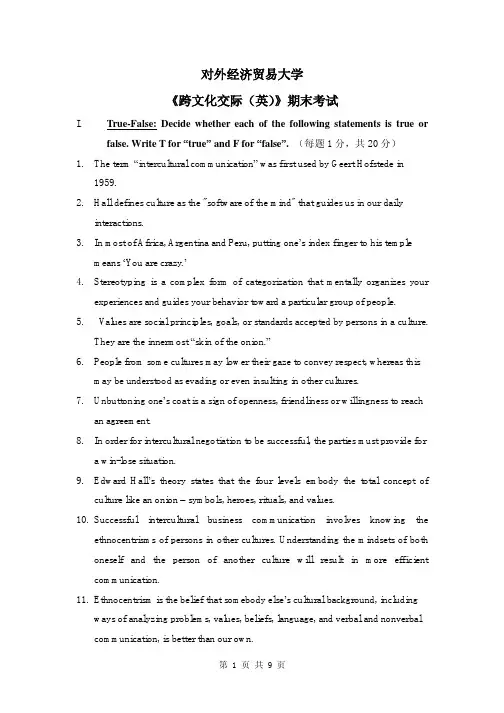
对外经济贸易大学《跨文化交际(英)》期末考试I.True-False: Decide whether each of the following statements is true orfalse. Write T for “true” and F for “false”.(每题1分,共20分)1.The term “intercultural communication” was first used by Geert Hofstede in1959.2.Hall defines culture as the "software of the mind" that guides us in our dailyinteractions.3.In most of Africa, Argentina and Peru, putting one’s index finger to his templemeans ‘You are crazy.’4.Stereotyping is a complex form of categorization that mentally organizes yourexperiences and guides your behavior toward a particular group of people.5.V alues are social principles, goals, or standards accepted by persons in a culture.They are the innermost “skin of the onion.”6.People from some cultures may lower their gaze to convey respect, whereas thismay be understood as evading or even insulting in other cultures.7.Unbuttoning one’s coat is a sign of openness, friendliness or willingness to reachan agreement.8.In order for intercultural negotiation to be successful, the parties must provide fora win-lose situation.9.Edward Hall’s theory states that the four levels embody the total concept ofculture like an onion – symbols, heroes, rituals, and values.10.Successful intercultural business communication involves knowing theethnocentrisms of persons in other cultures. Understanding the mindsets of both oneself and the person of another culture will result in more efficient communication.11.Ethnocentrism is the belief that somebody else’s cultural background, includingways of analyzing problems, values, beliefs, language, and verbal and nonverbal communication, is better than our own.12.People in the United States place a greater emphasis on history and do not likechange as compared with people of Asian and Latin cultures.13.When dealing with German business people, you should avoid jokes and otherforms of humor during the actual business sessions.14.In the business circle, American business people use first names immediately.panies should avoid sending female employees to the Middle East, as inArab countries men may refuse to work with women.16.In Southeast Asia, you should avoid presenting your business card with your righthand.17.When accepting a business card, German business people carefully look at thecard, observe the title and organization, acknowledge with a nod that they have digested the information, and perhaps make a relevant comment or ask a polite question.18.The OK sign may be interpreted as asking for money by Japanese businesspeople.19.Nonverbal communication is important to the study of interculturalcommunication because a great deal of nonverbal behavior speaks a universallanguage.20.In short, intercultural communication competence requires sufficient awarenessknowledge, motivations, and skills. Each of these components alone is sufficient to achieve intercultural communication competence.II.Translation: Translate the following Chinese terms into English and English terms into Chinese.(每题1分,共20分)1. stereotypes2. paralanguage3. ethnocentrism4. masculinity5. high-context culture6. monochronic time7. speech act 8. conversation taboos9. vocal qualifiers 10. power distance11. 译码12. 偏见13. 文化震惊14. 不确定性回避15. 概念意义16. 语用错误17. 礼貌原则18. 归纳法19. 空间语言20. 礼仪与礼节III.Multiple Choice: Choose the ONE appropriate answer.(每题1分,共20分)1. Understanding another culture ________.a.enables businesspeople to know why foreign associates believe and actas they dob.is best achieved through “do’s and don’ts” listsc.is important for businesspeople because they can appear to be betterinformedd.isn’t necessary for businesspeople2. Non-linear languages ______.a.are object orientedb.see time as a continuum of present, past and futurec.are circular, tradition oriented and subjectived.lead to short-range planning in business practices3. Which statement about values is incorrect?a. V alues are social principles, goals, or standards accepted by persons in aculture.b. V alues are learned by contacts with family members, teachers, andreligious leaders.c. V alues will be influenced by what is seen on television or read innewspapers.d. People in various cultures have basically similar values.4. People from cultures that follow the monochronic time system tend toa. do one thing at a time.b. be committed to people.c. borrow and lend things often.d. build lifetime relationships.5. Which statement regarding haptics is incorrect?a. In Thailand, it is offensive to touch the head.b. Japan is considered a "don't touch" culture.c. Greece is considered a "touch" culture.d. In Latin American countries, touching between men is unacceptable.6. The opinion that everyone has a position and clearly defined privileges is _____.a. a view of hierarchical structure of social relationshipb. a view of group orientation structure of social relationshipc. a view of individual orientation structure of social relationshipd.none of the above7. General guidelines to follow when conversing with someone from anotherculture include all of the following except:a. politics is a safe topic in most cultures.b. avoid telling jokes.c. avoid personal questions.d. keep the conversation positive.8. Which statement best describes an incorrect handshake?a. In the U.S., a handshake should be firm.b. An Asian handshake is usually gentle.c. Germans repeat a brusque handshake upon arrival and departure.d. A British handshake is firm and repeated frequently.9. Which statement referring to thought patterns is incorrect?a. Asians typically use the inductive method of reasoning.b. Thought patterns impact oral communication.c.When using the deductive method of reasoning, one starts with the factsand goes to generalizations.d. Recognizing different thought patterns is important in negotiation withdifferent cultures.10. Which statement is incorrect?a. Costly business blunders are often the result of a lack of knowledge ofanother culture's nonverbal communication patterns.b. Processes of reasoning and problem solving are the same in all cultures.c.Attitudes toward time and use of space convey nonverbal messages inintercultural encounters.d.When in another culture, an appropriate caution would be to watch thebehavior of the persons you are talking with and match their style.nguage is important because it _____a.helps us shape concepts, controls how we think, and controls how weperceive others.b.allows us to be understood by foreigners.c.is determined by colonialism.d.is stable, easily understood, and free of diversity.12. Which of the following countries uses high-context language?a.Canadab.Germanyc.Japand.United States13. Slang is generally _____a.understood by everyone.b.spoken by the masses.c.easily translated.ed by subgroups.14. Nonverbal communication does not include _____a. chromatics.b. chronemics.c.haptics.d. semantics.15. Dominance, harmony, and subjugation are all value orientations that correspond to which of the following cultural problems?a.What is the nature of human beings?b.What is the relationship of humans to nature?c.What is the orientation of humans to time?d.What is the human orientation to activity?16. Proverbs are significant to the study of intercultural communicationbecause_______.a.they provide a compact description of a culture’s valuesb.they tell a great deal about what a culture praises and what it rejectsc.they unite a people with the wisdom of their ancestorsd.all of the above17. Which statement highlights weak uncertainty avoidance?a. One group's truth should not be imposed on others.b. Scientific opponents cannot be personal friends.c. Citizen protest should be repressed.d. Negative attitudes are expressed toward young people.18. The main idea of the Sapir-Whorf Hypothesis is thatnguage is just a device for reporting a person's experience.b.two languages can represent the same social reality.c.the social reality can be conveyed to a person who does not speak thelanguage.nguage functions as a way of shaping a person's experience.19. Many multinational firms find that cultural shock can be alleviated bya. sending only top executives abroad.b. sending only young, single associates on overseas assignments.c. testing associates to see who is most qualified.d. selecting employees for overseas assignments who possess certainpersonal and professional qualifications.20. Which of the following statement is incorrect?a.Knowing cultural variations in the use of silence is helpful whenconversing with persons in another culture.b.We need to keep things in perspective and not get offended each time wedeal with someone who has a different attitude toward touchingc.Good advice when communicating with persons in other cultures is tokeep gestures to a minimumd.Although oral communication varies from culture to culture, non-verbalcommunication is almost always interpreted the same in each culture.IV.Answer the following essay question. (共20分)Compare and contrast the following proverbs from two different cultures: “It is the duck that squawks that gets shot”and “The squeaky wheel gets the grease.” How do people from these cultures perceive silence and talk? In light of their different perceptions, how might they view each other? What problems might arise in their interactions?V.Case Analysis: Analyze the following conversation from an intercultural perspective.(共20分)The following conversation took place between two Chinese friends.A: We’re going to New Orleans this weekend.B: What fun! I wish we were going with you. How long are you going to be there?A: Three days.B: Do you need a ride to the airport? I’ll take you.A: Are you sure it’s not too much trouble?B: No, no. It’s no trouble at all.Case Analysis: Analyze the following conversation from an intercultural perspective.参考答案及评分标准A卷VI.True-False: Decide whether each of the following statements is true or false. Write T for “true” and F for “false”.(每题1分,共20分)1. F2. F3. F4. T5. T6. T7. T8. F9. F 10. T11. F 12. F 13. T 14.T 15. T 16. F 17. F 18. T 19. T 20. FVII.Translation: Translate the following Chinese terms into English and English terms into Chinese.(每题1分,共20分)1. stereotypes 定势/刻板印象2. paralanguage 辅助语言/副语言3. ethnocentrism 民族中心主义4. masculinity男性特征5. high-context culture高语境文化6. monochronic time单一时间观念7. speech act 言语行为8. conversation taboos对话禁忌9. vocal qualifiers 声音修饰10. power distance权力距离11. 译码 decoding 12. 偏见 prejudice13. 文化震惊cultural shock 14. 不确定性回避 uncertaintyavoidance15. 概念意义denotational meaning 16. 语用错误pragmatic failure17. 礼貌原则the Politeness Principle 18. 归纳法inductivepattern19. 空间语言spatial language/proximics 20. 礼仪与礼节etiquetteand protocolVIII.Multiple Choice: Choose the ONE appropriate answer.(每题1分,共20分)1. a2. a3. d4. a5. d6. a7. a8. d9. c 10. b11. a 12. c 13. d 14. d 15. b 16. d 17. a 18. d 19. d 20. dIX.Answer the following essay question. (共20分)测试重点:Compare and contrast the proverbs “It is the duck that squawks thatgets shot”and “The squeaky wheel gets the grease.”The former is an English proverbwhile the latter is a Chinese proverb. In light of their different perceptions, the twocultures might differ in terms of silence and talk etc. and problems might arise in theirinteractions.评分标准:从以上角度进行分析,其他根据具体答题情况酌情。
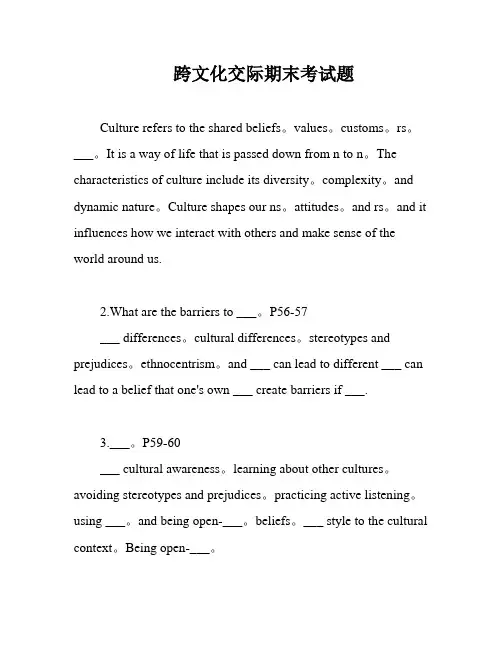
跨文化交际期末考试题Culture refers to the shared beliefs。
values。
customs。
rs。
___。
It is a way of life that is passed down from n to n。
The characteristics of culture include its diversity。
complexity。
and dynamic nature。
Culture shapes our ns。
attitudes。
and rs。
and it influences how we interact with others and make sense of the world around us.2.What are the barriers to ___。
P56-57___ differences。
cultural differences。
stereotypes and prejudices。
ethnocentrism。
and ___ can lead to different ___ can lead to a belief that one's own ___ create barriers if ___.3.___。
P59-60___ cultural awareness。
learning about other cultures。
avoiding stereotypes and prejudices。
practicing active listening。
using ___。
and being open-___。
beliefs。
___ style to the cultural context。
Being open-___。
4.What is the difference een individualism and collectivism。
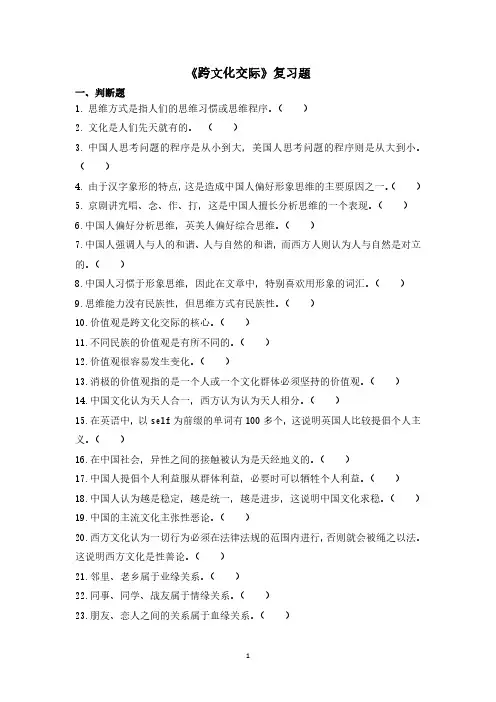
《跨文化交际》复习题一、判断题1.思维方式是指人们的思维习惯或思维程序。
()2.文化是人们先天就有的。
()3.中国人思考问题的程序是从小到大,美国人思考问题的程序则是从大到小。
()4.由于汉字象形的特点,这是造成中国人偏好形象思维的主要原因之一。
()5.京剧讲究唱、念、作、打,这是中国人擅长分析思维的一个表现。
()6.中国人偏好分析思维,英美人偏好综合思维。
()7.中国人强调人与人的和谐、人与自然的和谐,而西方人则认为人与自然是对立的。
()8.中国人习惯于形象思维,因此在文章中,特别喜欢用形象的词汇。
()9.思维能力没有民族性,但思维方式有民族性。
()10.价值观是跨文化交际的核心。
()11.不同民族的价值观是有所不同的。
()12.价值观很容易发生变化。
()13.消极的价值观指的是一个人或一个文化群体必须坚持的价值观。
()14.中国文化认为天人合一,西方认为认为天人相分。
()15.在英语中,以self为前缀的单词有100多个,这说明英国人比较提倡个人主义。
()16.在中国社会,异性之间的接触被认为是天经地义的。
()17.中国人提倡个人利益服从群体利益,必要时可以牺牲个人利益。
()18.中国人认为越是稳定,越是统一,越是进步,这说明中国文化求稳。
()19.中国的主流文化主张性恶论。
()20.西方文化认为一切行为必须在法律法规的范围内进行,否则就会被绳之以法。
这说明西方文化是性善论。
()21.邻里、老乡属于业缘关系。
()22.同事、同学、战友属于情缘关系。
()23.朋友、恋人之间的关系属于血缘关系。
()24.中国所处的自然地理位置决定了中国的农业文化特征,而西方的海洋环境决定了西方文化的商业性质。
()25.西方崇尚民主政治,具有平等意识。
()26.中国社会的人际关系以工具型为主要取向。
()27.规则和规范是一回事。
()28.在中国,给新婚夫妇送礼品忌讳送钟,因为送“钟”就是“送终”。
()29.在日本,人们比较忌讳数字“13”。
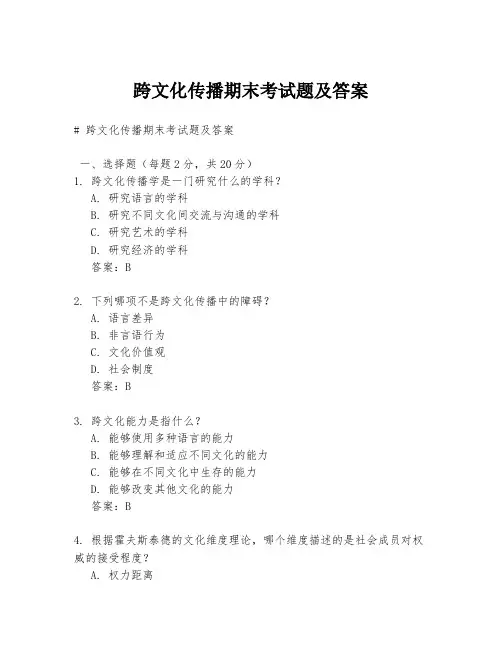
跨文化传播期末考试题及答案# 跨文化传播期末考试题及答案一、选择题(每题2分,共20分)1. 跨文化传播学是一门研究什么的学科?A. 研究语言的学科B. 研究不同文化间交流与沟通的学科C. 研究艺术的学科D. 研究经济的学科答案:B2. 下列哪项不是跨文化传播中的障碍?A. 语言差异B. 非言语行为C. 文化价值观D. 社会制度答案:B3. 跨文化能力是指什么?A. 能够使用多种语言的能力B. 能够理解和适应不同文化的能力C. 能够在不同文化中生存的能力D. 能够改变其他文化的能力答案:B4. 根据霍夫斯泰德的文化维度理论,哪个维度描述的是社会成员对权威的接受程度?A. 权力距离B. 个人主义与集体主义C. 男性化与女性化D. 长期导向与短期导向答案:A5. 在跨文化交流中,什么是“文化休克”?A. 一种文化中常见的现象B. 一种文化中不常见的现象C. 由于文化差异引起的心理不适感D. 由于文化差异引起的身体不适感答案:C...(此处省略其他选择题)二、简答题(每题10分,共30分)1. 简述跨文化传播中的“文化适应”概念。
答案:文化适应是指个体在面对新的文化环境时,通过学习、理解和适应新文化的行为规范、价值观念和交流方式,以减少文化冲突和提高跨文化沟通效果的过程。
2. 描述跨文化传播中的“文化冲突”及其解决策略。
答案:文化冲突是指不同文化背景的个体或群体在交流和互动过程中,由于价值观、行为规范和交流方式的差异而产生的矛盾和冲突。
解决策略包括:增强文化意识,学习对方的文化知识;采用开放式沟通,尊重差异;寻求共同点,建立互信;以及通过调解和协商解决具体问题。
3. 解释什么是“文化相对主义”及其重要性。
答案:文化相对主义是一种观点,认为每个文化都有其独特的价值和意义,应该在不以任何文化为标准的前提下去理解和评价其他文化。
其重要性在于促进跨文化理解和尊重,避免文化霸权和偏见,有助于构建和谐的国际关系和多元文化社会。

判断1 the iceberg model of culture implies that it is very difficult to understand a culture thoroughly文化的冰山模式意味着要彻底理解文化是非常困难的。
( T )2 culture is innate as soon as a person is born一个人出生就有文化( F )3 people may sometimes get confused about his or her cultural identity人们有时会对他或她的文化身份感到困惑。
( T )4 scholars prefer the term subculture to co-culture in describing a culture which exists witnin a dominant culture在描述一种存在显性文化的文化时,学者们倾向于亚文化到共同文化。
( F )5 a person could be a member of several different subgroups at the same time一个人可以同时成为几个不同的子组的成员。
( T )6 Intracultural communication occurs when the sender and the receiver from different races exchang messages文化的交流是发生在不同种族交换消息的发送者和接收者( F )7 communication and culture are inseparable and strongly connected沟通与文化密不可分,紧密相连。
( T )8 The sender must choose certain words or nonverbal to send an intentional message.this activity is called decoding发送者必须选择言语或非言语的发出故意这活动被称为解码( F )9 The process of communication has nine components :sender,encoding,message,channel,noise,decoding,feedback,and context 通信过程由九部分组成:发送方、编码、消息、信道、噪声、解码、反馈和上下文。
C.what is known D.which is known7、Lucia impressed her peer students with her musical talent, as well as several foreignlanguages ______. Array A.on her own B.under her control C.in her charge D.at her command8、She was in a ________ condition after the heart transplant operation when her body rejected the foreign organ.A.skeptical B.critical C.theoretical D.practical9、— Peter, you seem in high spirits.— ________ I have been offered a part-time job in the KFC .A.So what? B.No wonder.C.No doubt. D.Guess what.10、New policies, _______ to insure that compulsory education is truly free, ________ by the local government across China since the start of school on September 1.A.intending; have been made known B.intended; have been made known C.intending; are made known D.intended; had made known第二部分阅读理解(满分20分)阅读下列短文,从每题所给的A、B、C、D四个选项中,选出最佳选项。
《跨文化社交》考试一试卷Section I Listening Test[20 points]Part 1. Questions 1- 5 are based on this part. (10 points)You are going to listen to a panel discussion between two people on animal behavior. Choose the best answer from A, B, C and D for each question. Write your answers on the Answer Sheet.1. Madam Chair states that chimpanzee's altruism __________.A. is similar to that of beesB. may contain an element of self-interestC. is part of a group feeding systemD. is not a mutual-aid system2.Worker beeswork hard looking for food for 2 or 3 weeks, __________. A.and then die, leaving no offspringB. and then feed their offspringC. but die before feeding their offspringD. and then produce their offspring3.Chimpanzees who don't do their share of grooming are __________ by the group.A.criticizedB.acceptedC.exchangedD.rejected4.Male lions will cooperate in groups comprising __________. A.brothersB. brothers and sistersC. brothers and sisters and daughtersD. brothers and sisters and daughters and aunts5.Which of the following animals are being discussed in the conversation?A.bees,dogs, and lionsB.bees,chimpanzees, and fishC.bees,chimpanzees, and lions.D.chimpanzees , lions, and dogsPart 2. Questions 6-15 are based on this part. (10 points)You are going to listen to part of a lecture. As you listen, fill in the blanks with words from the lecture to complete the sentences that summarize the main points of the lecture. Write your answers on the Answer Sheet. Note: Each blank requires only ONE word.People communicate with one another all the time. Culture is regarded at the __6___ of communication challenges and it influences how people __7___ problems and participate in groups and in ___8___.One definition of culture given in the lecture is that "Culture refers to a group with which we share common experiences that __9___ how we understand the world."In the complex world, culture is one of the factors that act upon people. Anthropologists Keven Avruch and Peter Black explained that "culture provides the lens through which we view the world; the __10___ by which we order it; the _11___ by which the world makes sense."Since people coming from different cultural groups need to work together, cultural values sometimes __12___ and misunderstanding arises.The speaker mentioned six patterns of cultural differences which include: different communication styles, attitudes toward conflict, approaches to ___13____ tasks, decision making styles, attitudes toward __14___, and approaches to knowing.When talking about communication style, the speaker introduced two aspects: verbal and non-verbal communication. Non-verbal communication includes facial expressions, __15___, seating arrangements, personal distance, and senseof time.This is the end of the Listening Test.Section II Communicative Competence[30 points]Questions 16-30: Choose the best answer from A, B, C and D. Write your answers on the Answer Sheet.16. Which of the following statements is TRUE of collectivism? __________A. Collectivist cultures are described as "I" cultures.B. Members of collectivist cultures value open discussion of disagreement.C. Uniformity and conformity are stressedin collectivist cultures.D. Collectivists tend to draw attention to themselves and expressunique opinions.17.Just now I suddenly realized that I was totally to blame. I'll just have to face the music. The underlined part here means __________.A.to go to a concert and forget anything else by enjoying the musicB.to relax oneself by listening to the music aloneD. to go to seethe person who is in charge and ask what has gone wrong18. Which of the following statements is NOT true? __________A.Individualism can be traced to the philosophy of liberalism.B.The basic social unit in collectivist cultures is the autonomous self.C. Eastern collectivism is tied to Confucianism.D. Culture shock may occur at the individualist-collectivist divide, but the gap can be bridged.19. Bob is great! He always plays the game. The underlined part has the same meaning as__________.A.takes something as a game without caring too muchB.plays various gamesC.helps others when playing gamesD.behavesin a fair and honorable way20. Which of the following first names is shortened as "Bob"? __________A.RobertB.WilliamC.AlexanderD.Peter21. Which of the following statements is TRUE of the roots of English names? __________A."Forester" came from personal characteristics.B."Young" came from occupations.C."O'Patrick" came from family relationships.D. "Butler" came from places.22.If you received an English invitation to a formal western banquet but could not attend it, what would be an appropriate action? __________A. Ask a friend to attend the banquet for you.B. Ask a colleague to phone a refusal.C. Accept the invitation but then not attend.D. Write a reply informing the host/hostessthat you could not attend the banquet.23.Your American colleague has just had her hair dyed green. She is expecting your comment. What would you say appropriately? __________A. "Your hair is as green as tree leaves."24.Your classmate from Britain would like to borrow your computer this weekend. Unfortunately, you need to use it at the same time. How would you refuse the request politely? __________A. "Well, why don't you borrow one from someone else?"B. "Sorry, I cannot lend it to you."C. "Yes, but you need to give it back to me as soon as possible."D. "I'd love to, but I'm afraid I've got a lot of things to type up as well."25. Trying to explain rock music to your grandfather is just like dui niu tan qin ( 对牛弹琴)-playing violin to a bull. The corresponding English expression is __________. A.casting pearls before swineB. casting diamonds to a dogC. throwing pearls to a pigD. throwing diamonds to a goat26. Which of the following statements is TRUE of non-verbal communication? __________A. Non-verbal communication serves a variety of purposes.B. Non-verbal communication is less important than verbal communication.C. Since non-verbal communication is hard to interpret, it is important to reduce it to the minimum in cross-cultural communication.D. Non-verbal communication is not effective without verbal communication.27.The idiom "by the skin of one's teeth" means __________.A. very thinB. hard and flexibleC. only justD. one'ssenseof right and wrong28.What does the ring gesture (you form an "O" by holding the tip of your forefinger to the tip of your thumb) mean in Britain? __________A.Something is expensive.B.Something is good.C.Something is worthless.D.I will kill you.29. Which of the following statements is NOT true? __________A. Proxemics is the study governing how closely one person standsto another.B. All cultures draw lines between appropriate and inappropriate social distance for different relationships.C. Social distance has a wider range than public distance.D. The appropriateness of physical contact varies between cultures.30.If someone is said to be "economical with the truth", he/she __________A. has saveda lot of moneyB.does not tell the whole truthC. usesvery few wordsD. has recently diedSection III Reading Comprehension[30 points]Part 1. Questions 31- 35 are based on Passage1. (10 points)A handshake will be an acceptable greeting around the world. However, the strength, length, and duration of a handshake will vary by culture. Of course, Japanesewill still bow to each other and it is advisable for foreign visitors to bow slightly when shaking hands. Mexicans who know eachother will hug and East Europeans may kiss. In many European countries it is common to shake hands with everyone in the room before and after each businessmeeting.Business card exchanges are an important part of any international business meeting. Variations include where to keep your cards, which languages the card should be in, and what to do with the business card once you have received it. One rule to follow: Always bring five times more cards than you think you will need. To explore the nuances of business card exchange, we will examine the exchange as carried out by an American in Japan.First, the cards should be in English on one side and Japanese on the other. The Japanese side should have a logo or other marker. It is important that the company and title be prominently positioned. The cards should be kept in a card holder in the vest or jacket. Never keep the cards in a wallet or a pocketbook. The presentation of the card is done at the beginning of the meeting.Cards are presented with the giver's name (Japanese side) facing the recipient. The card can be delivered by one or preferably two hands accompanied by a slight bow. On receipt of a card, it should be studied carefully to determine the status of the person. Since meetings usually involve more than one person, each card received should be placed on the table, like an open deck of cards, in front of the recipient so that the executive can tell who he or she is speaking with. The recipient should avoid shuffling the cards, placing them in one's wallet, or writing on them in the presence of the giver. The business card is the symbolic embodiment of the organization; therefore it should be treated with the utmost respect.As a general rule, use people's titles on international business assignments. Learn the appropriate titles for each country. People with Ph.D.s should always be referred to as 'Doctor'. In many countries, people will be referred to by their titles only. For example, "Chief Engineer, can you tell us how this operation works?" The use of first names in business also varies by country and age. Be alert to these differences.Questions 31-35: Decide whether the following statements are true, false, or not mentioned according to the passage. Write T for "true", F for "false", and NM for "not mentioned" on the Answer Sheet._______31. Generally speaking, in Europe you should shake hands with everybody at the beginning and the end of a meeting._______32. You should always take at least five more business cards than you expect to need on your business trips._______33. In Japan, the person's status should be clearly given on the card._______34. It is acceptable for an American to note something down on a Japanesebusiness cardto remind him of the person who gave it to him._______35. The Japanesebusiness card is more than just a reminder of who the person is. It also representsthe company he works for.Part 2. Questions 36-40 are based on Passage2. (10 points)Passage2In an effort to get over culture shock, there is value in knowing something about the nature of culture and its relationship to the individual. In addition to living in a physical environment, an individual lives in a cultural environment consisting of manmade physical objects, social institutions, ideas and beliefs.An individual is not born with culture but only with the capacity to learn it and use it. There is nothing in a newborn child which dictates that it should eventually speak Portuguese, English, or French, nor that it should eat with a fork in its left hand rather than in the right, or use chopsticks. All these things the child has to learn. Nor are the parents responsible for the culture which theytransmit to their young. The culture of any people is the product of history and is built up over time largely through processes which are, as far as the individual is concerned, beyond his/her awareness. It is by means of culture that the young learn to adapt themselves to the physical environment and to the people with whom they associate.As we know, children and adolescents often experience difficulties in this process of learning and adjustment. But once learned, culture becomes a way of life, the sure, familiar, largely automatic way of getting what you want from your environment and as such it also becomes a value.People have a way of accepting their culture as both the best and the only way of doing things. This is perfectly normal and understandable. To this attitude we give the name ethnocentrism, a belief that not only the culture but the race and nation form the center of the world.Individuals identify themselves with their own group and its ways to the extent that any critical comment is taken as an affront to the individual as well as to the group. If you criticize my country, you are criticizing me. If you criticize me, you are criticizing my country.Along with this attitude goes the tendency to attribute all individual peculiarities as national characteristics. For instance, if an American does something odd or antisocial in a foreign country which back home would be considered a purely individual act, it is now considered a national trait.Instead of being censured as an individual, his country is censured. It is best to recognize that ethnocentrism is a characteristic of national groups. If a person criticizes some aspect of one's ownculture, one should listen but not enter into criticisms.Questions 36-40: Choose the best answer from A, B, C and D. Write your answers on the Answer Sheet.36. According to the passage,which of the following choices is NOT mentioned as an element in acultural environment?A.social institutionsB.beliefsC.historyD.physical objects37. What is the writer's stand about culture?A. Parentsare responsible for transmitting culture to their children.B. Children are born with culture.C. Culture needs to be taught to young people.D. Culture builds up over time and guides young people to adjust to environment.38.According to the passage, what is NOT suggested by the writer as a symptom of ethnocentrism?A. Regarding cultures containing similar values as the best cultures.B. Regarding home culture is superior to other cultures.39. What is the writer's attitude towards ethnocentrism in the article?A.positiveB.negativeC.neutralD.indifferent40.What does the word "censure" mean in the article?A. praiseB. criticizeC. evaluateD. judgePart 3. Questions 41- 45 are based on Passage3. (10 points)Passage3The Chinese make a clear distinction between insiders and outsiders, and this distinction exists on all levels of interpersonal interaction. Insiders consist of people from two categories: automatic and selected. Automatic insiders include one's parents, siblings, relatives, colleagues, andclassmates, whereas selected ones are special relations that one has developed over time at workor elsewhere. For example, a person is considered an insider at work after he or she has developeda special relationship by helping others and sharing information with others. The five common criteria of an insider are nice, trustworthy, caring, helpful, and empathetic.The distinction between an insider and an outsider provides specific rules of interaction in Chinese interpersonal relationships. Insiders often are treated differently from outsiders, and a person with insider status often enjoys privileges and special treatment beyond an outsider's comprehension. To illustrate, a Chinese person may go beyond his or her means to help an insider, but an outsider has to follow the rules. The insider-outsider distinction also involves moral implications. In the Chinese culture, moral judgments are not only cognitively but affectively based. Moral standstendto vary from one relationship to another.Family-centered "insider" relationships have two important implications for relationshipdevelopment with strangers. First, as King and Bond argue, the importance of family and the sense of dependency built up in the Chinese family system make it difficult to develop personal relationships with strangers. In the Chinese culture, the transformation from a wai ren (outsider) to a zi ji ren (insider) involves an arduous and time-consuming process, because personal relationships often take a long time to develop. After relationships have been established, however, they tend to stay very solid. As a result, in order to overcome the inherent difficulty in relationship development, intermediaries are widely used for social relationship construction. Second, the Chinese and other collectivistic cultures tend to be particularistic in their utilization of value standards toward in-groups and out-groups. This particularistic principle of interpersonal relationships hinders interactions with outsiders becausevalue standards applied to in-groups may not be readily adapted to out-groups, and most Chinese don't feel knowledgeable about dealing with outsiders.Questions 41-45: Answer the following questions briefly. Write your answers on the Answer Sheet.41.According to the author, what are the five common criteria of an insider?42.How do automatic insiders differ from selected ones?43. What example does the author give to show that insiders are treated differently from outsiders?44. According to the author, what makes it difficult for a Chinese person to develop a personal relationship with a stranger?45. What might be an appropriate title for this passage?Section IV Communication Analysis[20 points]The following are two cases of cross-cultural communication. In each of the cases there is something to be improved upon. Write an analysis on what is to be desired for more successful communication or cultural understanding. Your analysis should be about 100 words for each case. You may organize your analysis in accordance with the following procedure: why did the people involved behave so from the cultural perspective? What behaviors caused the misunderstanding in the case?What corrective behaviors do you suggestto each party in the case?Note: Your writing ability will be assessed.Case 1 (10 points)Li Hong is a new teacher in a middle school. One day, one of her Chinese colleague Yang Zhen introduces her to their middle-aged foreign teacher Maggy.Yang: Li Hong, this is Maggy, our English teacher from America. And Maggy, this is Li Hong, ournew colleague.Li and Maggy: How do you do?Maggy: Your sweateris so smart.Li: Oh, it is only an old one, I bought it last year.Maggy: You are so young and smart, I am sure you are a good teacher.Li: No, no. I am just a newcomer, I should learn from you old teachers.Maggy looks surprised and thinks, "I am really so old?"Question 46: Why did Li and Maggy behave so from the cultural perspective? What behaviors caused the misunderstanding in the case? What corrective behaviors do you suggest to Li and Maggy to avoid miscommunication?Case 2 (10 points)Li has returned to China after a year in the States. He marries his childhood sweetheart, who has never traveled and speaks very little English. Li's best friend in the States, Bob, comes to visit China for the first time and is introduced to Wang Lan, the new wife of his best friend."Gee, it's great to meet you", says Bob, "Li talked about you all the time back in Houston!" , and kisses Wang Lan heartily on both cheeks. Wang Lan is shocked.Question 47: Why did Bob and Wang Lan behave so from the cultural perspective? What behaviors caused the misunderstanding in the case? What corrective behaviors do you suggest to Bob and Wang Lan to avoid miscommunication?《跨文化社交》考试参照答案[20 points]Section I Listening TestPart 1. (10 points, 2 points each.)Part 2. (10 points, 1 point each. 0.5 point off for each misspelling.)6.root7.approachmunities9.shape10.logic11.grammar12.conflictpleting14.disclosure15.gesturesSection II Communicative Competence [30 points](30 points, 2 points each.)16. C 17. C 18. B 19. D 20. A21. C 22. D 23. B 24. D 25. A26. A 27. C 28. B 29. C 30. BSection III Reading Comprehension [30 points]31.T32.F33.NM34.F35.TPart 2. (10 points. Award 2 points to each correct answer.)36. C37.D38.A39.C40.BPart 3. (10 points) Award 2 points to each correct answer.41.The five common criteria of an insider are nice, trustworthy, caring, helpful, and empathetic.42.Automatic insiders include one's parents, siblings, relatives, colleagues, and classmates, whereas selected ones are special relations that one has developed over time at work or elsewhere.43.A Chinese person may go beyond his or her means to help an insider, but an outsider has to follow the rules.44. The importance of family and the sense of dependency built up in the Chinese family system (or value standardsapplied to in-groups may not be readily adaptedto out-groups).45.In-Groups and Out-Groups in China; Interpersonal Relations in China; Relating Foreigners in China, etc.Section IV Communication Analysis[30 points]The sample answers given in this part are more detailed than required in order to lead you through the three steps.In the examination, the students' analysis for each caseshould be about 100 words. Question 46.Case 1 (10 points, 1 point for overall language quality.)1.Li Hong comes from a collectivist culture which emphasizes deference paid to people older than self and modesty displayed on the part of the young. Maggy comes from an individualistic culture which values assertivenessand free expression of feelings. (2 points)2.As a young and new teacher, Li Hong showed her respect to Maggy with a formal greeting. When Maggy complimented Li on her sweater and herself, Li reacted in a typical Chinese way by overusing modesty in front of a teacher older than her. She displayed her humbleness by saying that her sweater was an old one and she should learn from Maggy, an old teacher. Li's responsesare perfect between Chinese people but terrible in cross-cultural situations like this. She did not realize that her expression of respect could be translated into offence since individualistic cultures do not associate as much deference with age as collectivistic cultures do. Therefore, Maggy, coming from an individualistic culture, was surprised when Li called her "old teacher". Maggy did not understand that the word "old" here meant as a compliment, meaning that she had richer teaching experience. Both Li Hong and Maggy communicated only from their cultural perspectives and thus caused miscommunication. (3 points)3.To avoid miscommunication, Li Hong and Maggy should learn more about each other's culture and adjust their behaviors accordingly. When Maggy complimented Li on her sweater and herself, Li could simply reply "thank you". She could use her non-verbal language to show her respect to Maggy, for instance, with a smile, a handshake, etc. (2 points) As to Maggy, she could use fewer complimentary words or more objective questions to reduce Li's nervousness. She should also understand that one of the key values in collectivism is deference paid to experience and old age. (2 points)Question 47.Case 2 (10 points, 1 point for overall language quality.)1. Bob comes from an individualistic culture which features close body contact among personal relationships. Wang Lan comes from a collectivistic culture which does not feature open display of personal feelings through body contact. (2 points)2.In the case, Bob treated Wang Lan as a close friend and greeted her in a typical western way with hearty kisses on her cheeks to display the close friendship. However, with little knowledge of western greeting etiquette, Wang Lan was shocked since Bob's "rude" behavior was not in line with the Chinese ways of expressing close friendship. In Chinese culture, a hearty handshake willserve the purpose. It is the contrast of Bob's open expression of closeness through close body contact and Wang Lan's indirectness in expressing her feelings that caused miscommunication. (3 points)3.To avoid miscommunication, Bob and Wang Lan need to learn more about each other's culture and adjust their behaviors accordingly. Bob should ask Wang Lan if he could kiss her to express his friendship or he could shake hands with Wang Lan instead. (2 points) Wang Lan needs to understand that the kisses were well meant and does not have to feel embarrassedor shocked. She could act more actively by extending her hand out first for a handshake rather than behave passively.(2 points)。
跨文化交际期末考试复习题跨文化交际期末考试复习题Define the following items:1.intercultural communication: is simply defined as interpersonal communication between people from different cultural background.2.interethnic communication: refers to communication between people of the same race but different ethnic backgrounds.3.verbal communication:communication done both orally and in written language.4.nonverbal communication: involves all nonverbal stimuli i n a communication setting that is generated by both the source and his or her use of the environment and that has potential message value for the source or receiver.4. Monochronic time一元时间观念: means paying attention to and doing only one thing at a time.5. Polychronic time多元时间观念: means being involved with many things at once.6. ethnocentrism :the view of things in which one’s own group is the center of everything, and all others are scaled and rated with reference to it.7. stereotypes:refers to negative or positive judgment made about individuals based on any observable or believed group时取代语言并影响信息的语意表达.munication noise干扰Any factor that hinders or distorts the reception of the message 15.Decoding解码The interpretative process of assigning meaning to a message.16.Denotation:is the conceptual meaning of the word that designates or describes things, events or processes,etc.17.Connotation:refers to the emotional or stylistic associations that a word or phrase suggests in one’s mind.18.space bubbleWhen people are having conversation with someone else, they generally like to have a little bubble of space all around them. This little bubble of space extends one or two or even three feet all around our bodies. We tend to view this as our personal space,even if we never think about it.19.reverse culture shock: is the name people give to that feeling of not fitting into your home country,and you are especially at risk of it if you return home after living abroad for an extended time.Answer the following questions:(1).What is the difference between individualism andcollectivism?An individualism culture is one in which people tend to view themselves as individuals and to emphasize the needs of individuals. It is regarded as a threat to the group and will result in punishment by the group in some country like Japan.A collectivism culture is one in which people tend to view themselves as members of groups (families, work units,tribes, nations) and usually consider the needs of individuals. It values the group above the individual,and individuals have a responsibility to the group that supersedes individual needs or rights.(2).Features of culture1.Culture is learned behaviour2.Culture is usually acquired unconsciously3.Culture is shared among its members4.Culture is persistent and enduring5.Culture manifests itself both implicitly and explicitly6.Culture is adaptive and changeable7.Culture is relational(3).What is Culture shock .............p129Culture shock is a feeling of frustration, uneasiness, or uncertainty that many people experience in unknown settings.Culture shock is a multifaceted experience resulting from numerous stressors occurring in contact with a different culture.Cause of Culture shock1.Stress reaction 3.role shock2.Cognitive fatigue 4.personal shock(4).Components of Communication:SenderAny person that produces the messageSource交际邀请The source is the person with an idea he or she desires to communicate.Code代码Any systematic arrangement or comprehensive collection of symbolsEncoding编码Encoding is the act of putting an idea or thought into a code. Message编码信息The term message is the content of interactionChannel交际渠道The mode by which a message moves from the source of themessage to the receiver of the message.Noise 干扰Any factor that hinders or distorts the reception of messages. Receiver交际接受The person that receives the message in the communication Response反应The reaction of the receiver to the decoded message Feedback反馈Information generated by the receiver and made available to a source that allows the source to make qualitative judgments about the communication while it is taking place(5) What is nonverbal communication?Nonverbal communication involves all nonverbal stimuli in a communication setting that is generated by both the source and his or her use of the environment and that has potential message value for the source or receiver.(6). Culture difference on lexical levelThe lexical meaning of culture difference can largely be grouped into two types:denotation and connotation. Denotation is the conceptual meaning of the word that designates or describes things, events or processes,etc. It is the primary,explicit meaning given in the definition of a word in adictionary.Connotation refers to the emotional or stylistic associations that a word or phrase suggests in one’s mind. It is the implicit, supplementary value which is added to the purely denotative meaning of a word or phrase.。
跨文化沟通期末考试题及答案一、选择题(每题2分,共20分)1. 跨文化沟通中,以下哪项不是文化差异的表现?A. 语言差异B. 饮食习惯C. 宗教信仰D. 个人兴趣答案:D2. 在跨文化沟通中,以下哪个行为可能被视为不礼貌?A. 握手B. 鞠躬C. 直视对方D. 赠送礼物答案:C3. 跨文化沟通中,以下哪个概念强调了文化对个体行为的影响?A. 个人主义B. 集体主义C. 权力距离D. 所有以上选项答案:D4. 根据霍夫斯泰德的文化维度理论,以下哪个维度不是其分类之一?A. 个人主义与集体主义B. 男性化与女性化C. 长幼有序D. 权力距离答案:C5. 在跨文化沟通中,以下哪个策略不是有效的沟通策略?A. 保持开放心态B. 避免使用肢体语言C. 尊重文化差异D. 积极倾听答案:B二、填空题(每空1分,共10分)6. 在跨文化沟通中,_________是指在不同文化背景下,人们对于同一事件或行为的不同理解和解释。
答案:文化相对主义7. 跨文化沟通的障碍之一是_________,即对其他文化持有偏见或刻板印象。
答案:文化偏见8. 跨文化沟通中,_________是指在不同文化间进行有效交流的能力。
答案:跨文化能力9. 跨文化沟通中,_________是指在不同文化背景下,人们对于时间的理解和使用方式。
答案:时间观念10. 跨文化沟通中,_________是指在不同文化背景下,人们对于空间的理解和使用方式。
答案:空间观念三、简答题(每题10分,共20分)11. 简述跨文化沟通中的语言障碍及其克服方法。
答案:语言障碍包括语言差异、非言语沟通差异等。
克服方法包括学习对方的语言、使用简单明了的表达、利用肢体语言辅助沟通、寻求翻译帮助等。
12. 描述跨文化沟通中的文化适应过程。
答案:文化适应过程通常包括四个阶段:蜜月期、文化休克期、调整期和融入期。
在蜜月期,人们对于新文化充满好奇和兴奋;文化休克期则可能感到困惑和挫败;调整期是逐渐适应新文化的过程;最后,在融入期,人们能够自如地在新文化中生活和工作。
期末英语专业跨文化交际试题试题及参考答案一、阅读理解(共30分)阅读下面短文,并根据文章内容选择正确答案。
Passage 1Communication styles and norms differ significantly between cultures, and understanding these differences is essential for successful cross-cultural communication.In some cultures, such as the United States and Canada, direct communication is highly valued. People tend to speak their mind openly and directly, even if it means disagreeing with others. They believe in being straightforward and assertive.On the other hand, in many Asian cultures, such as Japan and China, indirect communication is the norm. People are more likely to hint at what they mean rather than stating it outright. They often use nonverbal cues and context to convey their messages. This communication style values harmony and maintaining face.When engaging in cross-cultural communication, it is important to be aware of these differences and adjust your communication style accordingly. If you are from a direct communication culture, you may need to be more sensitive to nonverbal cues when interacting with individuals from an indirect communication culture.1. According to the passage, direct communication is highly valued in which cultures?A. Asian culturesB. United States and CanadaC. European culturesD. African cultures2. What is the communication style in Japan and China?A. Direct communicationB. Indirect communicationC. Nonverbal communicationD. Contextual communication参考答案:1. B2. B二、交际用语(共10分)根据对话情境和所给选项,选择恰当的答案完成对话。
第 1 页 共 4 页
跨文化交际期末考试题
跨文化交际期末考试题
Ⅰ. Define the following items. 1. context :P49 2.
noise: P54 3. intercultural munication :munication
between people whose cultural perceptions and symbol
systems are distinct enough to alter the munication event.
4. individualism: P99 5. collectivism: P99 6. high-
context culture :P110 a culture in which meaning is not
necessarily contained in words. Information is provided
through gestures, the use of space, and even silence. 7.
low-context culture :P110 a culture in which the
majority of the information is vested in the explicit
code. 8. verbal munication :munication done both orally
and in written language 9. nonverbal munication :
involves all nonverbal stimuli in a munication
setting that is generated by both the source and his
or her use of the environment and that has potential
message value for the source or receiver.
II. Answer the following questions(简答题) 1. What is
the culture, and what are the characteristics of the
culture? P45
第 2 页 共 4 页
what the behavior and customs mean to the people who
are following them.
2. What’s the relationship between culture and
language?
Culture influences language by way of symbols and
rules for using those symbols, as well as our perceptions
of the universe (the meaning associated with the
symbols).Language, on the other hand, would seem to have
a major impact on the way an individual perceives and
conceptualizes the world.
3. How do Japanese people refuse? P135
4. How do Chinese and western people respond to
others’ pliment? P162
5. What kinds of nonverbal munication are often used
in our daily munication? P191
6. What are the functions of the nonverbal munication?
P218
7.What are the differences on receiving gifts between
Chinese and westerner?
In the West, it is regarded as polite to open gifts
as soon as they are given to express appreciation. In
China, the situation is quite the reverse. Normally we
第 3 页 共 4 页
Chinese feel that if you open the gift as soon as it is
given, you might embarrass the person who gives the gift
and you might be thought greedy. Therefore, Chinese
people tend to open the gifts after the visitors have
left.
In China, many people send gifts without wrapping
them, and if they wrap them, they usually tell the
receiver what is inside, and the receiver will thank the
sender and put the gift aside without unwrapping them
since they already know what is inside. English
receivers open the gifts in front of the senders of the
gifts.
8. Describe the different ways in showing hospitality
between Chinese culture and western culture.
Chinese guests always refuse offer of drinks or food
to demonstrate politeness in seeming not to wish to put
their host to any trouble.Sometimes an offer is not a
real offer but a polite remark. After we say 'no', we
usually wait for the second and third offer. If the host
just brings the food or drink and ignores 'no', we ill
accept it. Chinese like to press their guests to drink or
eat to show their hospitality. While westerners always
第 4 页 共 4 页
accept or refuse offer of drinks or food very
genuinely.Their refusal is acce
pted as genuine.Westerners don’t to press. To press
people to have food or drink after they have refused is
frowned upon and can cause embarrassments.
III. Case Analysis (You are required to state
cultural phenomenon in each case) Case 1
Li Lan had an American friend Susan. They usually had
lunch together and Li Lan often asked Susan for advice on
problems she faced adjusting to American society. Susan
gave Li Lan a lot of advice and helped her to improve her
English. Once Li Lan needed urgently a big sum of money
to pay her tuition fee. Since she has no other friends in
the States, she turned to Susan for help and promised
that she would return the money soon.
To Li Lan’s great disappointment, this time Susan
didn’t seem happy to lend the money